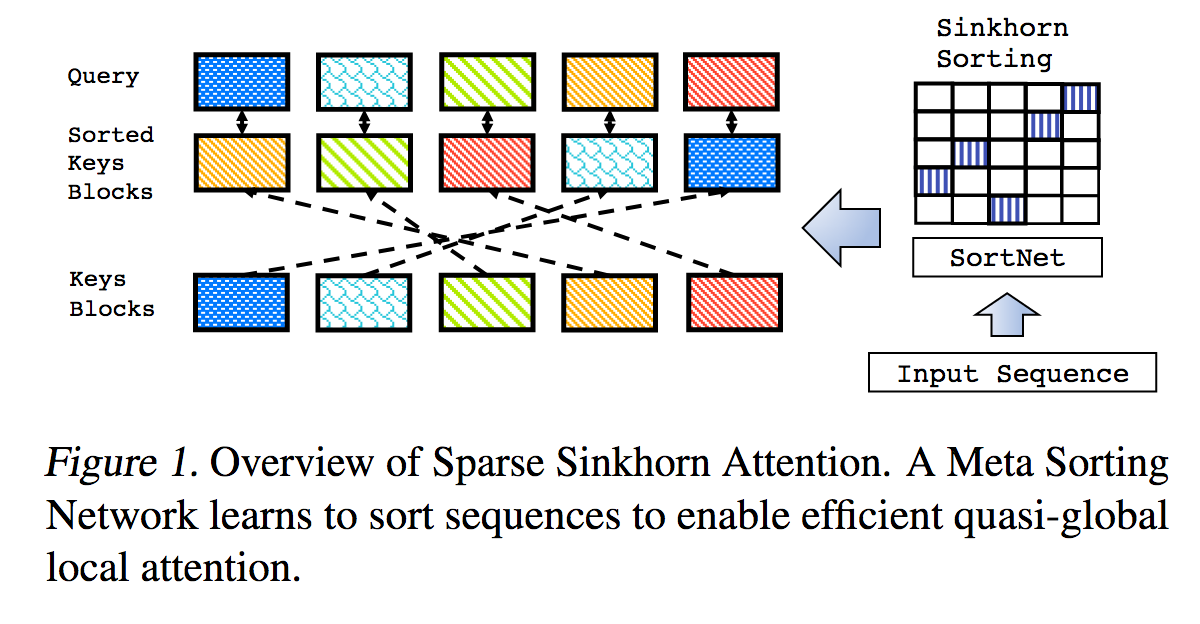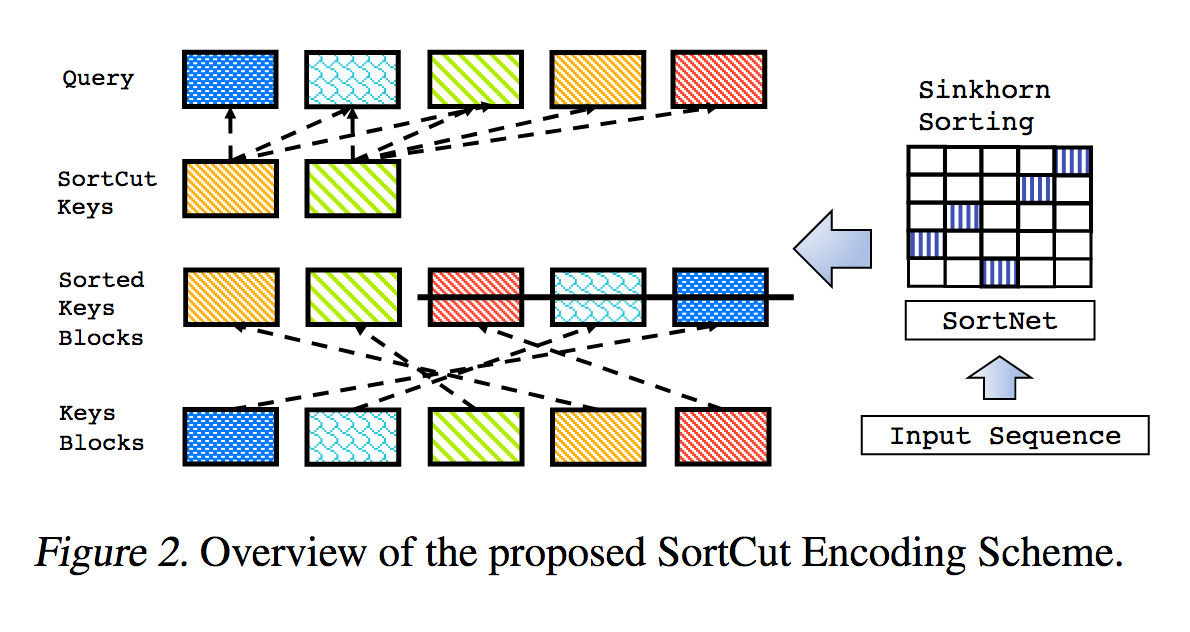Sinkhorn Transformer
This is a reproduction of the work outlined in Sparse Sinkhorn Attention, with additional enhancements.
It includes a parameterized sorting network, using sinkhorn normalization to sample a permutation matrix that matches the most relevant buckets of keys to the buckets of queries.
This work also brings in reversible networks and feed forward chunking (concepts introduced from Reformer) to bring about further memory savings.
204k tokens (demonstration purposes)
Install
$ pip install sinkhorn_transformerUse
A Sinkhorn Transformer based language model
import torch
from sinkhorn_transformer import SinkhornTransformerLM
model = SinkhornTransformerLM(
num_tokens = 20000,
dim = 1024,
heads = 8,
depth = 12,
max_seq_len = 8192,
bucket_size = 128, # size of the buckets
causal = False, # auto-regressive or not
n_sortcut = 2, # use sortcut to reduce memory complexity to linear
ff_chunks = 10, # feedforward chunking, from Reformer paper
reversible = True, # make network reversible, from Reformer paper
ff_dropout = 0.1, # feedforward dropout
attn_dropout = 0.1, # post attention dropout
attn_layer_dropout = 0.1, # post attention layer dropout
layer_dropout = 0.1, # add layer dropout, from 'Reducing Transformer Depth on Demand' paper
weight_tie = True, # tie layer parameters, from Albert paper
emb_dim = 128, # embedding factorization, from Albert paper
ff_glu = True, # use GLU in feedforward, from paper 'GLU Variants Improve Transformer'
n_local_attn_heads = 2, # replace N heads with local attention, suggested to work well from Routing Transformer paper
)
x = torch.randint(0, 20000, (1, 2048))
model(x) # (1, 2048, 20000)A plain Sinkhorn Transformer, layers of sinkhorn attention
import torch
from sinkhorn_transformer import SinkhornTransformer
model = SinkhornTransformer(
dim = 1024,
heads = 8,
depth = 12,
bucket_size = 128
)
x = torch.randn(1, 2048, 1024)
model(x) # (1, 2048, 1024)Sinkhorn Encoder / Decoder Transformer
import torch
from sinkhorn_transformer import SinkhornTransformerLM
DE_SEQ_LEN = 4096
EN_SEQ_LEN = 4096
enc = SinkhornTransformerLM(
num_tokens = 20000,
dim = 512,
depth = 6,
heads = 8,
bucket_size = 128,
max_seq_len = DE_SEQ_LEN,
reversible = True,
return_embeddings = True
).cuda()
dec = SinkhornTransformerLM(
num_tokens = 20000,
dim = 512,
depth = 6,
causal = True,
bucket_size = 128,
max_seq_len = EN_SEQ_LEN,
receives_context = True,
context_bucket_size = 128, # context key / values can be bucketed differently
reversible = True
).cuda()
x = torch.randint(0, 20000, (1, DE_SEQ_LEN)).cuda()
y = torch.randint(0, 20000, (1, EN_SEQ_LEN)).cuda()
x_mask = torch.ones_like(x).bool().cuda()
y_mask = torch.ones_like(y).bool().cuda()
context = enc(x, input_mask=x_mask)
dec(y, context=context, input_mask=y_mask, context_mask=x_mask) # (1, 4096, 20000)Autopadder
By default the model will complain if given an input that is not a multiple of the bucket size. To avoid having to make the same padding calculations each time, you can use the helper Autopadder class. It will take care of the input_mask for you as well, if given. Contextual key/values and mask are supported as well.
import torch
from sinkhorn_transformer import SinkhornTransformerLM
from sinkhorn_transformer import Autopadder
model = SinkhornTransformerLM(
num_tokens = 20000,
dim = 1024,
heads = 8,
depth = 12,
max_seq_len = 2048,
bucket_size = 128,
causal = True
)
model = Autopadder(model, pad_left=True) # autopadder will fetch the bucket size and autopad input
x = torch.randint(0, 20000, (1, 1117)) # odd sequence length
model(x) # (1, 1117, 20000)Sinkhorn
This repository has diverged from the paper and is now using attention in place of the original sorting net + gumbel sinkhorn sampling. I have not found a noticeable difference in performance yet, and the new scheme allows me to generalize the network to flexible sequence lengths. If you would like to try Sinkhorn, please use the following settings, which only works for non-causal networks.
import torch
from sinkhorn_transformer import SinkhornTransformerLM
model = SinkhornTransformerLM(
num_tokens = 20000,
dim = 1024,
heads = 8,
depth = 12,
bucket_size = 128,
max_seq_len = 8192,
use_simple_sort_net = True, # turn off attention sort net
sinkhorn_iter = 7, # number of sinkhorn iterations - default is set at reported best in paper
n_sortcut = 2, # use sortcut to reduce complexity to linear time
temperature = 0.75, # gumbel temperature - default is set at reported best in paper
non_permutative = False, # allow buckets of keys to be sorted to queries more than once
)
model = torch.randint(0, 20000, (1, 8192))
model(x) # (1, 8192, 20000)Citations
@misc{tay2020sparse,
title = {Sparse Sinkhorn Attention},
author = {Yi Tay and Dara Bahri and Liu Yang and Donald Metzler and Da-Cheng Juan},
year = {2020},
url. = {https://arxiv.org/abs/2002.11296}
}@inproceedings{kitaev2020reformer,
title = {Reformer: The Efficient Transformer},
author = {Nikita Kitaev and Lukasz Kaiser and Anselm Levskaya},
booktitle = {International Conference on Learning Representations},
year = {2020},
url = {https://openreview.net/forum?id=rkgNKkHtvB}
}@misc{lan2019albert,
title = {ALBERT: A Lite BERT for Self-supervised Learning of Language Representations},
author = {Zhenzhong Lan and Mingda Chen and Sebastian Goodman and Kevin Gimpel and Piyush Sharma and Radu Soricut},
year = {2019},
url = {https://arxiv.org/abs/1909.11942}
}@misc{shazeer2020glu,
title = {GLU Variants Improve Transformer},
author = {Noam Shazeer},
year = {2020},
url = {https://arxiv.org/abs/2002.05202}
}@misc{roy*2020efficient,
title = {Efficient Content-Based Sparse Attention with Routing Transformers},
author = {Aurko Roy* and Mohammad Taghi Saffar* and David Grangier and Ashish Vaswani},
year = {2020},
url = {https://openreview.net/forum?id=B1gjs6EtDr}
}@inproceedings{fan2020reducing,
title ={Reducing Transformer Depth on Demand with Structured Dropout},
author ={Angela Fan and Edouard Grave and Armand Joulin},
booktitle ={International Conference on Learning Representations},
year ={2020},
url ={https://openreview.net/forum?id=SylO2yStDr}
}

